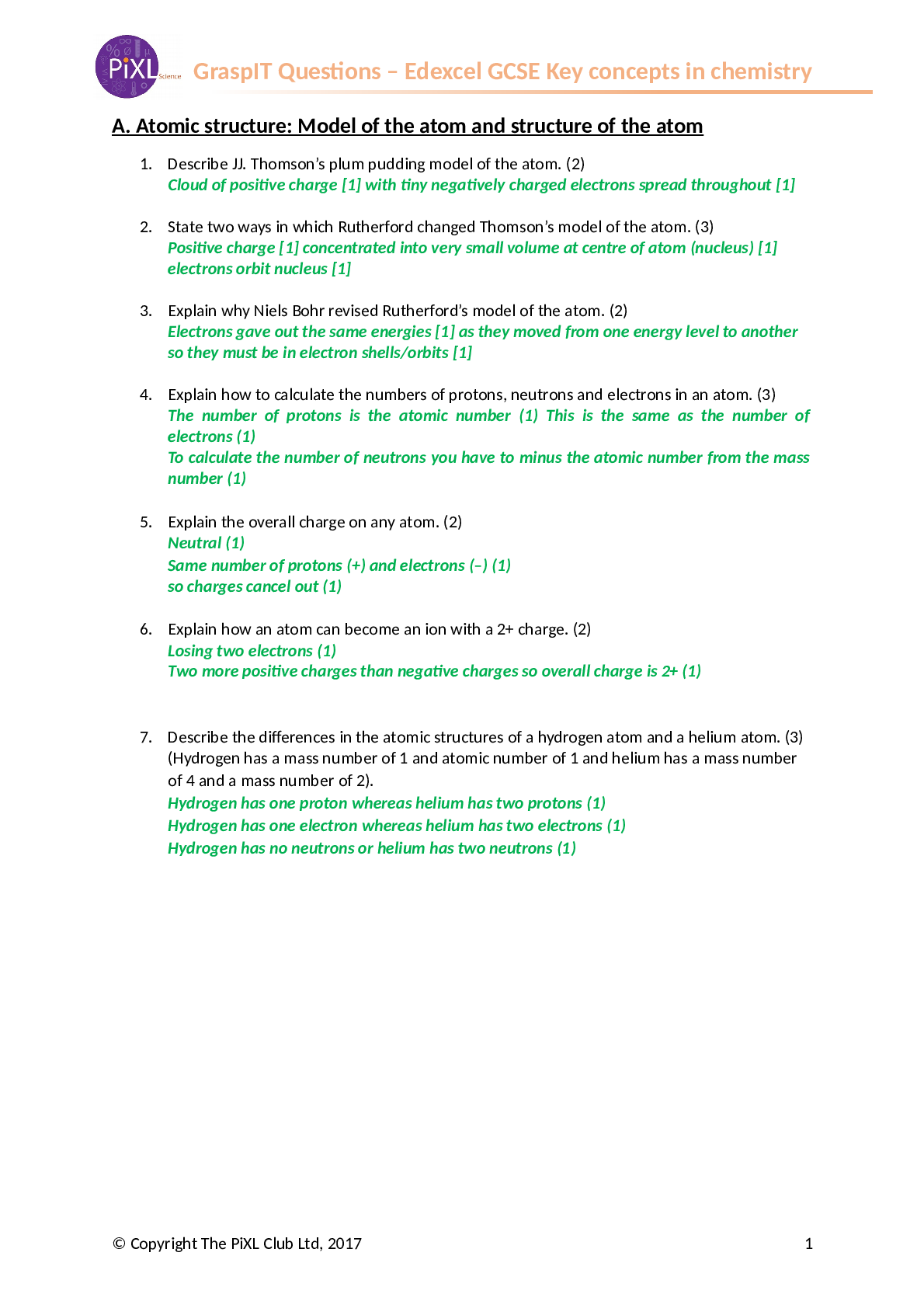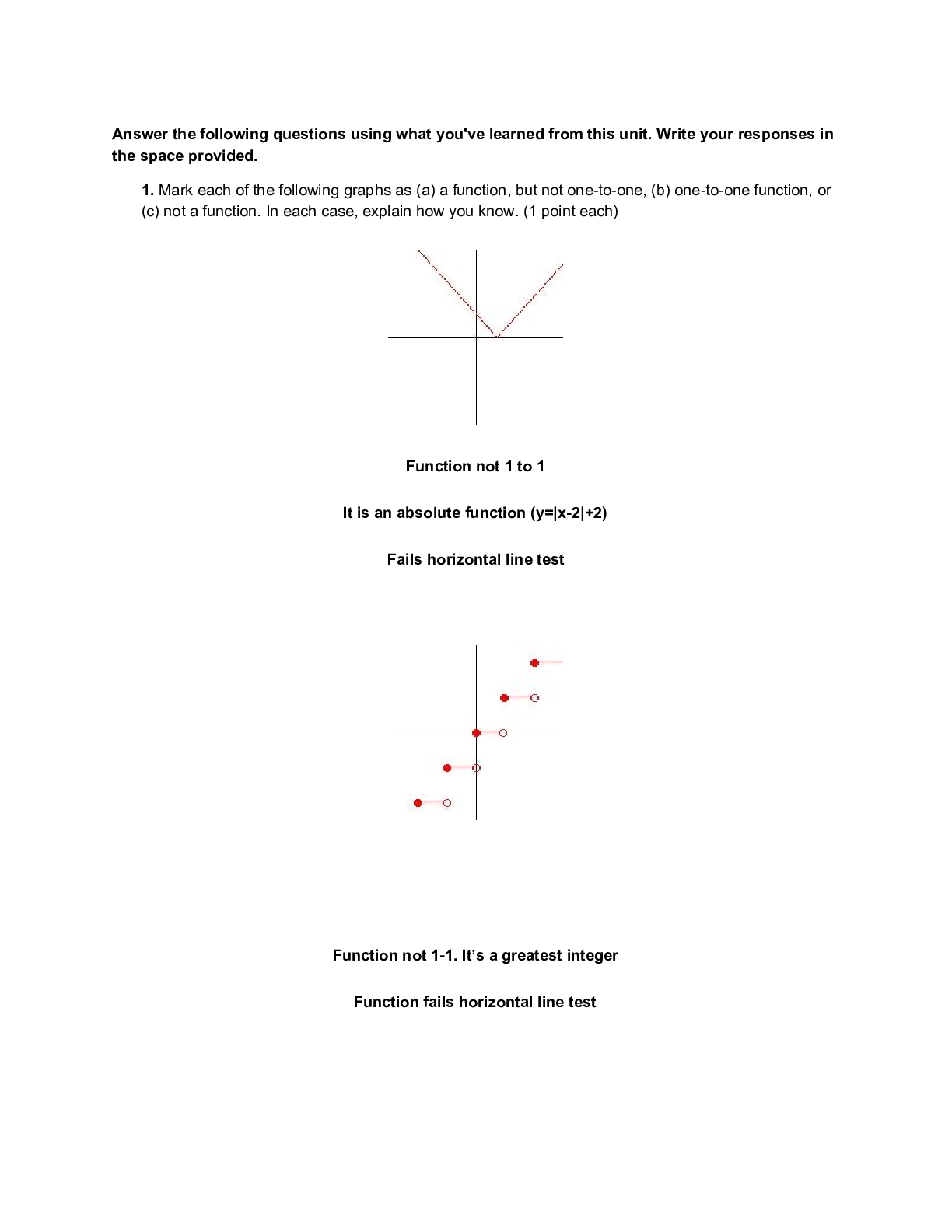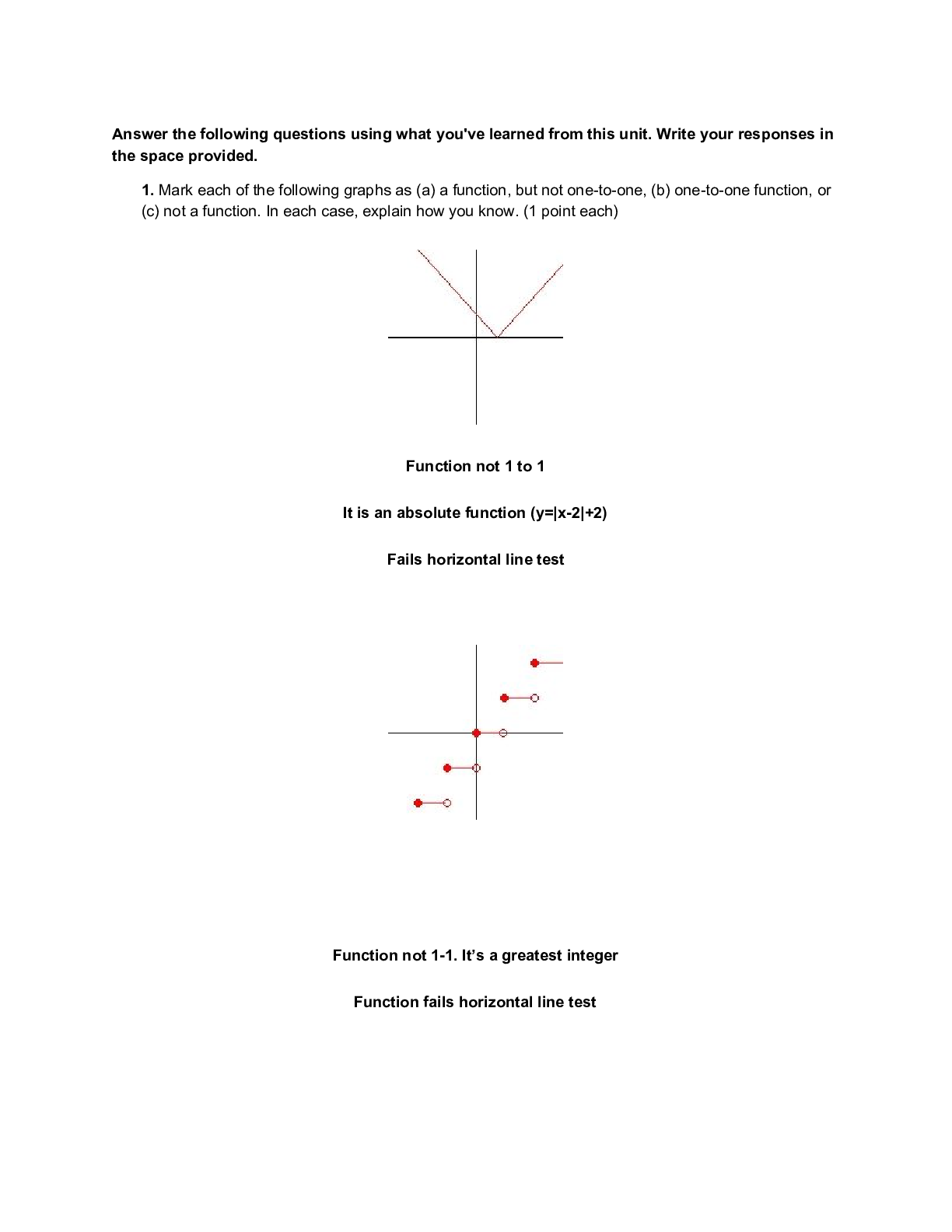Chemistry > QUESTIONS & ANSWERS > Edexcel_Chemistry_Key concepts in chemistry_GraspIT_GCSE_ ANSWERS (All)
Edexcel_Chemistry_Key concepts in chemistry_GraspIT_GCSE_ ANSWERS
Document Content and Description Below
GraspIT Questions – Edexcel GCSE Key concepts in chemistry A Atomic structure: Model of the atom and structure of the atom 1 Describe JJ Thomson’s plum pudding model of the atom (2) 2 S... tate two ways in which Rutherford changed Thomson’s model of the atom (3) 3 Explain why Niels Bohr revised Rutherford’s model of the atom (2) 4 Explain how to calculate the numbers of protons, neutrons and electrons in an atom (3) 5 Explain the overall charge on any atom (2) 6 Explain how an atom can become an ion with a 2+ charge (2) 1 GraspIT Questions – Edexcel GCSE Key concepts in chemistry 7 Describe the differences in the atomic structures of a hydrogen atom and a helium atom (3) (Hydrogen has a mass number of 1 and atomic number of 1 and helium has a mass number of 4 and a mass number of 2) B Atomic structure: Isotopes and relative atomic mass 1 Explain why isotopes of the same element have identical chemical properties (2) 2 There are two principal stable isotopes of chlorine - 35Cl and 37Cl The relative atomic mass of chlorine is 355 Explain what this shows about the abundance of the two isotopes (2) 3 Demonstrate that the relative atomic mass of a sample copper is 635 using the following information about the relative abundance of its isotopes: 30% Cu- 65; 70% Cu- 63 (2) 2 GraspIT Questions – Edexcel GCSE Key concepts in chemistry 4 A sample of copper contains 30% Cu- 65 and 70% Cu- 63 Describe the structure of the two forms of copper and explain why, in this sample, boron has a relative atomic mass of 635 (6) C Periodic table: Mendeleev, atomic number, metals and non-metals and electronic configuration 1 Explain how Dmitri Mendeleev constructed his periodic table (2) 2 Explain how the scientific community were influenced to accept Dmitri Mendeleev’s version of the periodic table (4) 3 GraspIT Questions – Edexcel GCSE Key concepts in chemistry 3 Explain how the position of an element in the periodic table is related to the arrangement of electrons in its atoms (2) 4 Explain why elements in many groups of the periodic table have similar chemical properties (1) 5 Group 4 elements contain a mixture of metals and non-metals Explain, using its position in the periodic table, whether germanium is a metal or a non-metal (2) 6 Element X is found in group 7 and period 2 in the periodic table Use this information to predict its electron configuration and explain your working (3) D Ionic bonding 1 Explain the charges on the following ions: a) Na+ b) O2- 4 GraspIT Questions – Edexcel GCSE Key concepts in chemistry 2 Sodium chloride NaCl and sodium oxide have ionic bonds a) Draw dot and cross diagrams to show what happens to sodium and chlorine atoms when they react to form sodium chloride You only need to show the outer electrons in your diagrams (3) b) Draw dot and cross diagrams to show what happens to sodium and oxygen atoms when they react to form sodium oxide (3) 3 Use your periodic table to calculate the numbers of protons, neutrons and electrons in the following ions: a) Na+ (1) b) O2- (1) 5 GraspIT Questions – Edexcel GCSE Key concepts in chemistry 4 Explain the formation of ions from their atoms for Group 1 and 2 metals (3) 5 Explain the structure of the ionic compound sodium chloride (5) 6 Deduce the formula for the following ionic compounds given the following formulae of their constituent ions: Ca2+; O2-; Mg2+; F-; Al3+ a) Calcium oxide (1) b) Magnesium fluoride (1) c) Aluminum oxide (1) 6 GraspIT Questions – Edexcel GCSE Key concepts in chemistry E Covalent bonding 1 Explain how a covalent bond is formed (4) 2 Draw a diagram to represent the covalent bonding between two chlorine atoms (2) 3 Why don’t simple molecular substances conduct electricity? (1) 4 Nitrogen gas has a very strong triple covalent bond holding the atoms together Explain why nitrogen has a boiling point of -196°C (2) 5 Describe what is meant by intermolecular forces (1) 7 GraspIT Questions – Edexcel GCSE Key concepts in chemistry F Properties of substances: Ionic substances, simple molecular compounds (covalent) 1 Explain why ionic compounds have high melting points and boiling points (2) 2 Why can ionic compounds conduct electricity when they are molten or dissolved in water? (1) 3 Why is seawater a better conductor of electricity than freshwater? (1) 4 Explain why oxygen has a low boiling point (1) 8 GraspIT Questions – Edexcel GCSE Key concepts in chemistry 5 Explain the difference in the ability of solid sodium fluoride and molten sodium fluoride to conduct electricity in terms of their structures (6) G Properties of substances: Diamond, graphite, graphene, fullerenes and polymers 1 Graphite is sometimes used to reduce the friction between two surfaces that rub together Explain how it does this (2) 9 GraspIT Questions – Edexcel GCSE Key concepts in chemistry 2 Extended response question: Describe how the structures of diamond and graphite are similar and explain why graphite can conduct electricity, but diamond cannot (6) 3 State which properties of graphene make it useful in the manufacture of bullet-proof vests (2) 4 Explain why Graphene is such a good conductor of electricity (5) 5 10 GraspIT Questions – Edexcel GCSE Key concepts in chemistry 6 Ethene C2H4 can be polymerised to Poly(ethene) a) Explain in terms of its structure why ethene is a gas at room temperature (2) b) Explain in terms of its structure why poly(ethene) is a polymer (2) c) Explain why poly(ethene) has a high melting point (1) 11 GraspIT Questions – Edexcel GCSE Key concepts in chemistry H Properties of substances: Metals and the limitations of models 1 This diagram shows a model of metallic bonding: a) Why are the particles that makeup a metal described as positively charged ions? (2) b) What are delocalised electrons? (2) 2 Explain the bonding in a metal using the theory of metallic bonding (4) 12 GraspIT Questions – Edexcel GCSE Key concepts in chemistry 3 Extended response question: Copper is a good metal for making a kettle because it has a high melting point Explain why copper has a high melting point You should describe the structure and bonding of a metal in your answer 4 The following diagram shows a model of how ions are arranged in the ionic substance magnesium chloride Explain the disadvantages of using this model to represent an ionic compound (2) 13 GraspIT Questions – Edexcel GCSE Key concepts in chemistry I Calculations involving masses: Relative formula mass 1 Calculate the relative formula mass of Na2CO3 (1) 2 Calculate the relative formula mass of NH4NO3 (1) 3 Calculate the relative atomic mass of Iron (with 58% 54Fe, 918% 56Fe, 21% 57Fe and 03% 59Fe) (2) J Calculations involving masses: Empirical and molecular formulae 1 Describe an experiment to determine the empirical formula of magnesium oxide (6) 14 GraspIT Questions – Edexcel GCSE Key concepts in chemistry 2 An oxide of lead was analysed by a chemist 0828g of lead was combined with 0128g of oxygen in this sample Calculate the empirical formula of this lead oxide Relative atomic masses: O 16; P 207 3 An experiment was conducted to determine the empirical formula of magnesium oxide a) Suggest why the lid of the crucible had to be raised occasionally during the heating process (1) b) Write a balanced symbol equation for the reaction between magnesium and oxygen (2) c) Deduce the empirical formula from the following results for the experiment (3) Relative atomic masses: Mg 24; O 16 Mass of magnesium used / g Mass of magnesium oxide formed /g Mass of oxygen in magnesium oxide /g 010 016 006 15 GraspIT Questions – Edexcel GCSE Key concepts in chemistry K Calculations involving masses: Conservation of mass 1 Describe the law of conservation of mass (1) 2 During thermal decomposition of copper carbonate (CuCO3) a student noticed the mass of the copper oxide formed was less than the mass of the copper carbonate at the start of the experiment Explain, using an equation, why this reaction still follows the law of conservation of mass (3) L Calculations involving masses: Masses of reactants and products from balances equations; concentration of solution 1 A technician made up a solution of sodium hydroxide by placing 500g of solid sodium hydroxide in a flask and adding 100cm3 of water She placed in the stopper and shook until the reaction had stopped What was the concentration of the solution in g/dm3? (1) 2 A solution of copper chloride has a concentration of 300g/dm3 What is the mass of copper chloride in 500cm3 of the solution? (2) 16 GraspIT Questions – Edexcel GCSE Key concepts in chemistry 3 Higher: Explain how the mass of a solute and the volume of water effect the concentration of a solution (2) 4 How many moles of sulfur atoms are there in: a) 98 grams of sulfur? (1) b) 16 tonnes of sulfur? (where 1 tonne = 1000kg) (1) 5 What is the mass of: a) 004 moles of hydrogen H2? (1) b) 06 moles of sodium nitrate (NaNO3)? (2) 17 GraspIT Questions – Edexcel GCSE Key concepts in chemistry 6 When calcium reacts with water it forms a solution of calcium hydroxide Ca(OH)2 and hydrogen gas a) Write a balanced symbol equation, including the state symbols to show this equation (3) b) Calculate how much calcium must be added to an excess of water to produce 37g of calcium hydroxide (2) 7 What mass of sodium chloride is produced when 53g of sodium carbonate reacts with excess dilute hydrochloric acid? (3) Na2CO3 + 2HCl 2NaCl + H20 + CO2 18 GraspIT Questions – Edexcel GCSE Key concepts in chemistry 8 84 tonnes of nitrogen were mixed with 30 tonnes of hydrogen in the following equation: N2(g) + 3H2(g) 2NH3(g) a) Calculate the number of moles of nitrogen and hydrogen and calculate which reactant is the limiting factor (3) b) Calculate the maximum mass of ammonia that can be produced from 42 tonnes of nitrogen (3) M Calculations involving masses: Moles and stoichiometry 1 What is meant by the term ‘Avogadro constant’? Include a value for the constant in your response (2) 2 How many atoms of carbon would be found in 10g? (2) 3 How many moles are there in 42g of carbon? (1) 19 GraspIT Questions – Edexcel GCSE Key concepts in chemistry 4 Explain why, in a reaction, the mass of the product formed is controlled by the mass of the reactant not in excess (3) 5 0010 moles of C4H10 reacts with oxygen as in the following equation: C4H10 + O2 ___CO2 + ___H20 176g of carbon dioxide and 090 of water are produced Use this information to work out the balancing numbers for carbon dioxide and water (4) [Show More]
Last updated: 1 year ago
Preview 1 out of 12 pages

Buy this document to get the full access instantly
Instant Download Access after purchase
Add to cartInstant download
We Accept:

Reviews( 0 )
$6.00
Document information
Connected school, study & course
About the document
Uploaded On
Aug 21, 2022
Number of pages
12
Written in
Additional information
This document has been written for:
Uploaded
Aug 21, 2022
Downloads
0
Views
80














